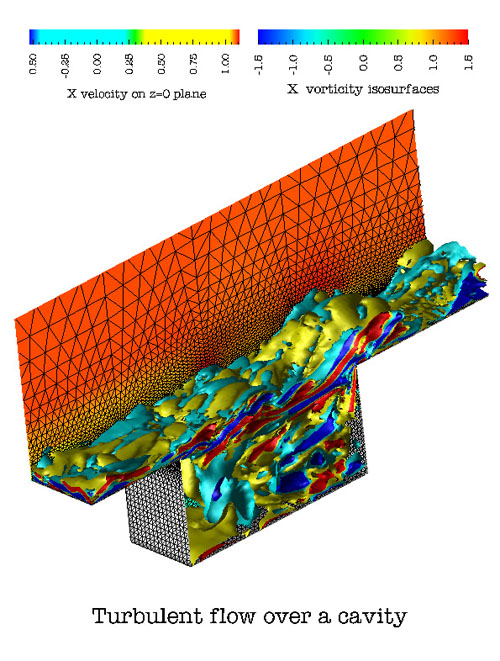
Computational Fluid Dynamics
Turbulence Simulation
In many flows of practical interest, turbulence plays a non-negligible role. To this end, our turbulence research, at the most applied level, seeks to develop simple models that describe the net effect or average of the turbulence upon the mean flow equations (the Reynolds-averaged Navier-Stokes (RANS) equations). These models, when combined with a fully unstructured-grid finite element method, allow engineers to model arbitrarily complex flow problems. Currently we have implemented and tested a general class of one and two equation models with development of full Reynolds stress transport models underway. Unfortunately, RANS models are not yet able to describe all turbulent flows with sufficient accuracy. Therefore, other forms of simulating turbulence are also pursued. These forms are: 1) Large-Eddy Simulation (LES) where the large scale motions of the turbulence are resolved in the computation leaving only the fine scale motions to be modeled; 2) Direct Numerical Simulation (DNS) where all of the turbulent motions are resolved in the computational model. These alternate forms are useful both to develop a more basic understanding of the theory of turbulence and to help improve the averaged models used by engineers. All three levels of modeling have been developed with compressible and incompressible flow solvers.

Large-eddy simulations underway include a study of a high lift airfoil where 10 million nonlinear equations were solved at each time step for 150 thousand time steps making this one of the largest fully unstructured grid simulations undertaken to date (1.5 trillion nonlinear equations solved). While it will be some time before design engineers can bring this level of computational power to bear on these problems, it is expected that these simulations can provide information that will improve existing RANS models in use today. Other simulations include flow over a notch, flow within an IC engine, flow near the exit of a jet engine, and more basic, well-understood flows such as decay of isotropic turbulence and channel flow. The above simulations where the first applications of the dynamic Smagorinsky model to unstructured grid calculations.
To enable these models to be applied to real world flows, our research is also focused on improvements to the numerical methods used to solve the various forms of the Navier-Stokes equations. In particular, research is underway in parallel, adaptive approaches that utilize varying grid size and varying order interpolation functions to improve the approximation of the numerical method (stabilized finite element method). Further research is underway in the development of error estimators and error indicators that are necessary to drive this h-p adaptivity. This aspect of the problem is particularly difficult for unsteady flows where previously proposed error indicators may suggest adaptivity too often or too late (i.e. fine scale structures are constantly moving). We have recently proposed an applied statistics based error adaptivity that seems to hold great promise for unsteady flows.
We are also undertaking a significant effort to develop new models for large eddy simulation that take advantage of the natural sum decomposition of scales afforded to finite element methods when using a hierarchical basis. We have called this new model the Variational Multiscale Model because it makes use of finite element projections rather than filters to separate the scales. Early results presented at the APS-DFD meeting compared very favorably to the dynamic model (better in most respects).
An exciting new area of research within our group is hybrid turbulence modeling. Here we are considering models which behave like RANS models in regions where RANS solutions are acceptable and like LES models where higher fidelity is required. There are two variants to this approach: "Zonal", where explicit regions are defined to be LES and RANS respectively and boundary conditions are matched at the interface and "DES" (Detached Eddy Simulation) models where the local mesh size dictates the model character.
The above flow and turbulence models have not only been applied to single phase flows but also to multiphase flows including deposition processes and liquid-gas suspensions, the latter requiring the introduction of level set equations to keep track of the liquid-gas interface.
For more information see Professor Jansen's page.
Rotorcraft Aerodynamics
